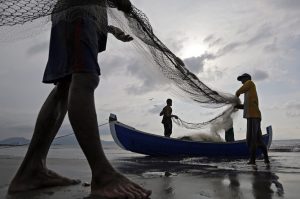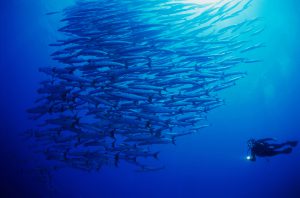Fish that are a major source of food for billions on the planet have suffered a “catastrophic” decline of nearly three quarters in the past four decades, according to new research.
WWF and the Zoological Society of London said in the Living Blue Planet report that over-fishing, pollution and climate change had a major role in the shrinkage of commercial fish stocks, such as Tuna and Mackerel, over the period.
“In the space of a single generation, human activity has severely damaged the ocean by catching fish faster than they can reproduce while also destroying their nurseries,” said Marco Lambertini, head of WWF International, in a statement.
“Profound changes are needed to ensure abundant ocean life for future generations,” he said. “Considering the ocean’s vital role in our economies and its essential contribution to food security – particularly for poor, coastal communities – that’s simply unacceptable,” he added.
The report, an updated study of seaborne mammals, birds, reptiles and fish, showed a decline of 49% in the size of marine populations between 1970 and 2012.
Although over-exploitation is identified as the major threat to ocean biodiversity, the study also found that climate change had caused the oceans to change more rapidly than at any other point in millions of years.
Rising temperatures and increasing acidity levels caused by carbon dioxide are further weakening a system that is already severely degraded through overfishing, habitat degradation and pollution, the report added.
The WWF report recommended several measures to slow the depletion of fish stocks and protect marine species. They are:
– Ecosystem services and natural assets: These areas should be considered in every decision that affects the marine environment, as only 3.4% of the world’s marine areas are currently protected. Co-ordinated action is needed to reach the Aichi Target, agreed under the Convention on Biological Diversity, to protect at least 10% of coastal and marine areas by 2020.
– Sustainable fisheries: Better management in fisheries is vital to reverse plummeting stocks of fish species and rebuild fish stocks to ecologically sustainable harvest levels. Almost 10% of wild-caught seafood globally now comes from fisheries certified by the Marine Stewardship Council (MSC). MSC certification helps stocks to be managed sustainably and minimise the impacts on marine ecosystems and species.
Also see: Can the WTO curb dangerous overfishing?
– Consume more wisely: Pressure from consumers and retailers for more responsibly produced seafood has encouraged producers to commit to Aqua Stewardship Council (ASC) and MSC certification. Consumer choice can also influence service industries, such as tourism, to operate in more responsible ways that benefit marine ecosystems and coastal communities.
– Redirect financial flows: Investment patterns and harmful subsidies continue to promote overfishing and unsustainable exploitation, despite the strong economic case for investing in preserving and restoring marine natural capital and sustainable production. Loans could be made available for conservation measures and social support necessary to put fishery on a sustainable footing, to be repaid through profits from increased future yields.
– Political alliances: Establish a “Blue Alliance” of countries, as well as concerned organisations and businesses, to drive action to restore our oceans to a healthy state. This would include raising and accessing funds to invest in restoring habitats, reforming fisheries (including small-scale fisheries), reducing pollution and building resilience to climate change.
– Equitable resource governance: Governments shouldn’t have sole responsibility for protecting or restoring the ocean. Communities and responsible businesses must also be engaged.






